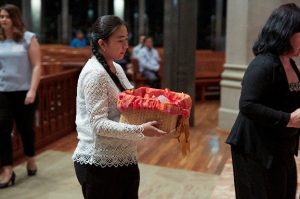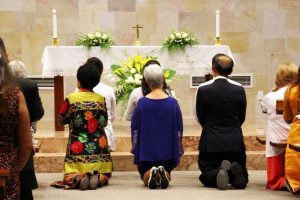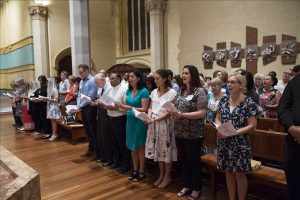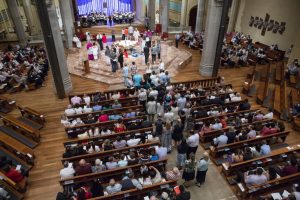What is the Rite of Christian Initiation of Adults (RCIA)?
The Rite of Christian Initiation of Adults (RCIA) is a process of Christian formation by which those who are seeking full communion with the Church. RCIA may also be referred to as ‘the Catechumenate’.
The RCIA is a process, not a program. It is a process which responds to Christ’s invitation to unbaptised (catechumens), and to candidates (those who have received Baptism in other Christian denominations), to come and see how the Catholic community live, pray and worship. The process supports those seeking to deepen their personal relationship with Christ through developing familiarity with the Gospel teachings, deepening the personal experience of prayer and worship and help discern the movement of the Holy Spirit.
The process has several stages and ritual steps, leading up to the reception of all three sacraments of Initiation: Baptism, Confirmation and Eucharist, usually at the Easter Vigil.
Conversion to Christ is at the heart of this journey both for those seeking membership of the Church and the parish community. The Priest, Parish Catechist, Sponsors and Godparents, together with the prayers and welcome of the wider Parish community, provides the hospitality for new members to fully assimilate and actively engage in the liturgical life of the Church. This why this journey takes place within the parish community.
Who is the RCIA for?
RCIA is for
- Adults who want to be baptised
- Baptised Christians of other faith denominations who are interested in becoming Catholic
- baptised Catholics who have not completed full initiation
What is the RCIA Journey
There are four stages to the RCIA journey. Each stage concludes with a community ceremony called a Rite, which acts as a starting point for the next stage of the journey. At each Rite those on travelling the journey affirm their intention to proceed to the next stage while the community commits to supporting them on their journey. The four stages of the RCIA process are:
[RCIA 1-35]
Major Rites and Stages of the RCIA Process
The initiation of new members into the Church is a gradual process allowing enquirers time to grow in faith and become full participants of the Catholic community.There are four stages in the RCIA process, each one concludes with a community ceremony, known as a ‘Rite’ which acts as a starting point for the next stage.
STAGE ONE PERIOD OF ENQUIRY
The period of period of inquiry known as the period of Evangelisation and Pre-Catechumenate is a time within the process that allows enquirers to come and see what the Catholic faith is about and have an opportunity to explore the beliefs of the Catholic church and ask questions. This stage of the RCIA is a time of unhurried reflection and discovery. During this period enquirers are introduced to the Gospel and begin to search out God’s call to enter more fully into the life of the Church. This period lasts as long as the person needs it to last, from a few months to several years, if necessary.
During this period, some may decide that this is not the right time for them to consider membership in the Catholic Church, either because of their own life circumstances or because they feel some other tradition is better for them.
The Rite of Acceptance and Welcome
Joined to the Church, the catechumens are now part of the household of Christ, since the Church nourishes them with the word of God. [RCIA 47]
To mark the end of this stage, the Rite of Acceptance for catechumens (those who are unbaptised) and the Rite of Welcome for candidates (those whom have already been baptised in a Christian denomination) are celebrated. These Rites are a formal welcome and introduction to the wider parish of those beginning the RCIA journey. The warmth and role of the Parish community of faith is an integral part in the sense of belonging that those seeking to become Catholic experience.
This Rite is a gateway to the second stage of the RCIA, the Catechumenate.
[RCIA 36-47]
STAGE TWO PERIOD OF THE CATECHUMENATE
The catechumenate is an extended period during which the candidates are given suitable pastoral formation and guidance, aimed at training them in the Christian life. In this way, the dispositions manifested at their acceptance into the catechumenate are brought to maturity. [RCIA 75]
The Period of the Catechumenate embodies the first stage of commitment leading to full membership into the Catholic Church. During this period, the initial conversion is deepened the person comes to know more and more deeply the love of God in their own lives and in the midst of the Church community. The faith of the catechumens is deepened through prayer, reflection and through the Word of God. Catechumens gather with the Catholic community on Sundays for the first part of the Mass, (the Liturgy of the Word). After the homily, catechumens are dismissed, and with their Catechist, continue a process of reflection and application of the Scriptures to their own lives.
In this period, Catechumens receive anointings, participate in prayers of exorcism and blessings to assist their conversion of heart and mind to God.
The duration of the catechumenate will depend on the grace of God and on various circumstances … By means of sacred rites celebrated at successive times they are led into the life of faith, worship, and charity belonging to the people of God. [RCIA 76]
This period, too, lasts as long as the person needs it to last, from a few months to several years, if necessary. For the unbaptised, this phase must normally last 12 months.
The Archdiocese of Perth recommends three forms of catechesis are offered over the catechumenate that is: Lectionary, Liturgy and Instructional catechesis.
The Rite of Election
The Church believes that no one comes to faith without being called by God. God initiates, God calls, God converts. The Archbishop of the dioceses, speaking for the Church, articulates God’s invitation and election to those electing to become full members of the Catholic faith.

The Rite of Election is a major step in the faith journey of catechumens and candidates in the RCIA process, as well as for the whole Archdiocese. In this Rite, which normally occurs on the First Sunday of Lent, the Church makes its ‘election’, i.e. chooses the catechumens who, up to this point, have spent much time in formation to move on to the sacraments of initiation at Easter. Those baptised Christians who are seeking to complete their initiation into the Catholic Church are also welcomed by the Archbishop, where the faith community shows its support for all who are being called into the life of the Church.
The unbaptised catechumens and those candidates baptised in other Christian denominations will be introduced to the Archbishop by their sponsors. Their names will be inscribed in the Book of Elect for the Catechumens (unbaptised) and the Book of Recognition for the Candidates.
The Rite of Election is celebrated at the Cathedral, where all those preparing to become Catholic at Easter share in the one ceremony.
[RCIA 75-92]
STAGE THREE THE PERIOD OF PURIFICATION AND ENLIGHTENMENT
 The Period of Purification and Enlightenment corresponds to the time known in the Catholic Church as Lent, the six-weeks of preparation for Easter. This period becomes a prayerful time for catechumens and candidates, who are now known as the Elect, as they prepare for the moment of welcome as full members of the Catholic Church.
The Period of Purification and Enlightenment corresponds to the time known in the Catholic Church as Lent, the six-weeks of preparation for Easter. This period becomes a prayerful time for catechumens and candidates, who are now known as the Elect, as they prepare for the moment of welcome as full members of the Catholic Church.
Throughout Lent, special prayers are offered at the Sunday Eucharist for the catechumens and candidates; they are called scrutinies. These prayers for strengthening in grace and virtue and for purification from all past evil and from any bonds which hinder them from experiencing the love of God. Throughout this period, the Elect are invited to join with the whole Church in a deeper practice of works of charity and in the practice of fasting.
During this period, the common reflection on the Scriptures continues; the readings of Lent were chosen with the themes of continuing conversion in mind. Toward the end of this period, the Church continues the custom of ‘handing over’/entrusting to the Elect the Creed (the summary of our faith) and the Lord’s Prayer.
At the conclusion of the period, the catechumens and candidates are initiated into the Catholic Church during the Easter Vigil.
[RCIA 125-136]
The Sacraments of Initiation
When we were baptised we joined with Jesus in death so that we might walk in the newness of his life.
The Sacraments of Initiation are celebrated at the Easter Vigil. At the Easter Vigil, the Elect are Baptised, Confirmed and received their first Holy Communion. marking full membership in the Church. Candidates enter into full communion with the Church through a Profession of faith, Confirmation and receiving Holy Communion. From this time the newly initiated are known as neophytes for the first year of their new life in Christ.
[RCIA 198-210]
STAGE FOUR THE PERIOD OF MYSTAGOGY AND BEYOND
 The Period of Mystagogy is a time set aside to help new members (now called neophyte) reflect on what they have just gone through at Easter and look to the future as to how they can now share in the mission of Christ. This period of time reminds the whole church that life in Christ constantly calls us to grow and to look for new ways to live the life of grace, personally and together.
The Period of Mystagogy is a time set aside to help new members (now called neophyte) reflect on what they have just gone through at Easter and look to the future as to how they can now share in the mission of Christ. This period of time reminds the whole church that life in Christ constantly calls us to grow and to look for new ways to live the life of grace, personally and together.
This period lasts from Easter Sunday until the completion of the Easter season, fifty days later, on Pentecost Sunday. This marks the completion of the initiation process. While it marks the closing of the RCIA process, it is the beginning of a new life as fully initiated members of the Catholic Church.
.
STAGE FOUR PERIOD OF MYSTAGOGY/POSTBAPTISMAL CATECHESIS
This is the time for the community and the neophytes together to grow in deepening their grasp of the paschal mystery and in making it part of their daily living through the meditation of the Gospel, sharing in the Eucharist, and in doing works of charity. [RCIA 234]
The fourth stage of the Rite of Christian Initiation of Adults is called “mystagogy.” The newly baptized are now called “neophytes,” from the Greek words meaning “new plant,” because the faith has been newly planted in them. This is a period in which the community is called to accompany the new Catholics as they discover what it means to fully participate in the sacramental mysteries of the Church.
Even though their catechetical preparation has been completed, they still have much to learn about what it means to live as Catholic Christians. The neophytes need the ongoing support of the community so that the faith newly planted in them can grow deep roots.
Traditionally the stage of mystagogy extends throughout the Easter season, until the feast of Pentecost. However, is is strongly encouraged that the Godparent(s) continue to walk with the neophytes for at least one year after their initiation, inviting them to become active in the life of the parish.
During Lent
The Scrutinies
These rites, therefore, should complete the conversion of the Elect and deepen their resolve to hold fast to Christ and to carry out their decision to love God above all. [RCIA 128]
On the third, fourth and Fifth Sundays of Lent the Scrutinies are celebrated by the Elect. The Scrutinies are rites which “heal all that is weak, defective, or sinful in the hearts of the elect” and “to give them strength in Christ, who is the way, the truth, and the life”. The rite also describes the scrutinies as “rites for self-searching and repentance”. (RCIA 128) The Elect making their final preparation for Baptism, examine their lives and ask the entire Christian community to pray that whatever is weak and sinful within them may be eliminated and that whatever is good and holy may be affirmed. For this reason, the Scrutinies are also known as the rites of healing and strengthening.
The period of catechesis following the scrutinies is primarily a time of support and care for the Elect, helping them see the presence of God’s love in the midst of the painful naming of sin. The focus is on God’s love, not on our sin. It is the time to be preoccupied with the freedom of being a child of God, and anything that keeps us from living that vocation to its fullness.
Presentation of the Creed and the Lord’s Prayer
… with the catechumenal formation of the Elect completed, the Church lovingly entrust them [the Elect] the Creed and the Lord’s Prayer, the ancient texts that have always been regarded as expressing the heart of the Church’s faith and prayer. [RCIA 134]
The Creed and the Lord’s Prayer are at the heart of our faith. They embody what we believe and how we are to pray, which is why special liturgies are designed to hand on or to present both in the Rite of Christian Initiation of Adults.
Since the early centuries, the Creed and the Lord’s Prayer have been presented to the Elect in the weeks prior to Easter to help them prepare for Baptism.
The Creed
The Creed … recalls the wonderful deeds pf God for the salvation of the human race…
[RCIA 134]
The presentation of the Creed, takes place during the week after the first scrutiny. The Creed is a proclamation of belief: this is what we believe, what we settle our hearts on. By presenting the Creed, the Church gives the Elect the articles of faith that she professes in the one, true God: Father, Son and Holy Spirit.
The Lord’s Prayer
The Lord’s prayer has been the prayer proper to those who in baptism have received the spirit of adaption
[RCIA 136]
The presentation of the Lord’s Prayer, takes place during the week after the third scrutiny. The Lord’s Prayer is the quintessential prayer of the Church. This is the prayer that Jesus gave his disciples when they ask him how to pray and today is given to the Church as the blueprint for prayer. Through the Lord’s Prayer Jesus teaches he teaches us to give praise to God, petition God for our needs and the needs of the world, ask forgiveness, and pray in thanksgiving for all the blessings that God showers upon us.



